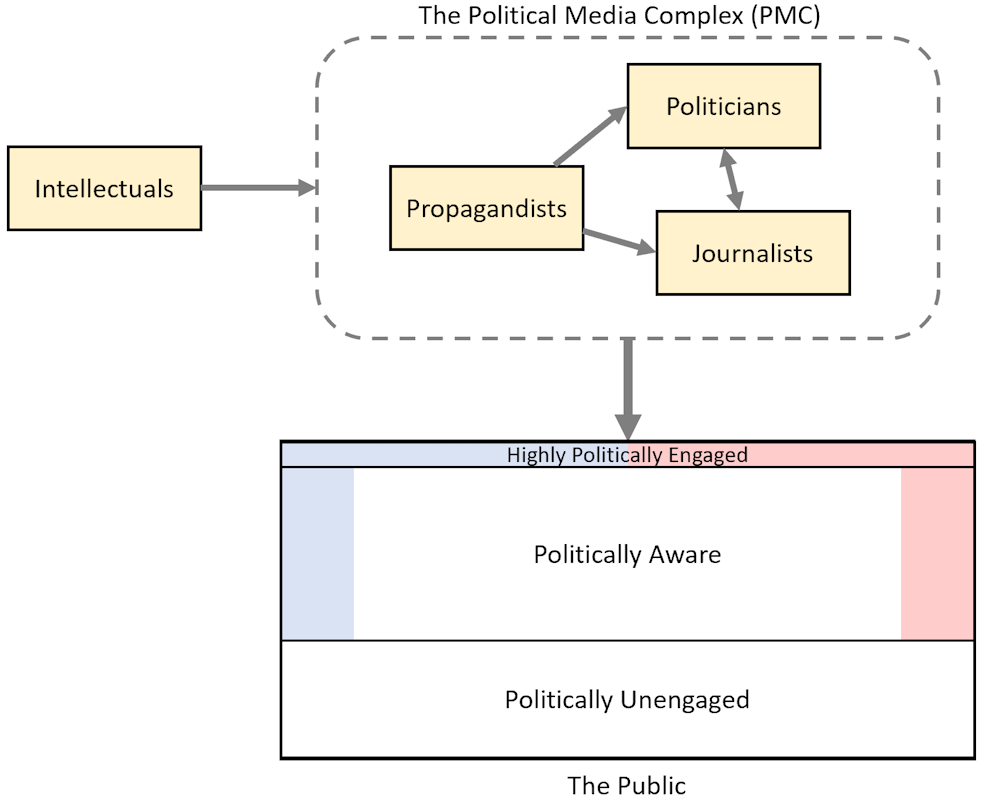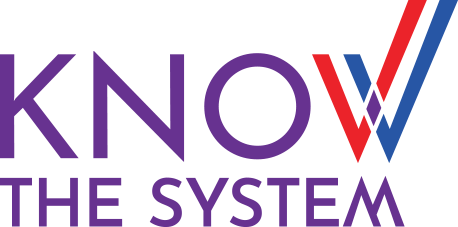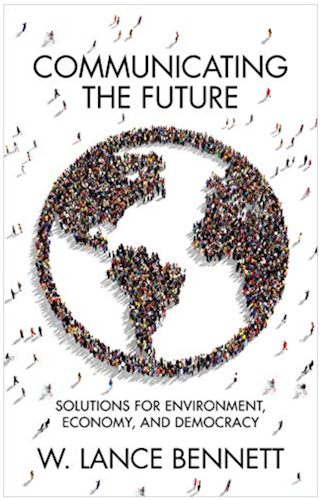A review of Communicating the Future
(Author: Lance Bennett)
In just the last 20 years, annual global CO2 emissions have increased by over 40%. Obviously it is unrealistic to expect the modern industrial society to turn on a dime, and the rate of emissions growth has slowed recently. But there is much room for discouragement. The 2015 Paris Agreement’s goal of limiting the global temperature increase to 2°C seems unrealistic.
I’ve been wanting to read Lance Bennett’s 2020 book for quite a while now, because of the combination of my interest in popular climate rhetoric and my deep admiration for Bennett’s earlier classic, News: The Politics of Illusion. Communicating the Future is full of valuable insights and ideas for addressing a problem in desperate need of new approaches. As a communications scholar who has researched how ideas travel through complex network ecologies, Bennett is well positioned to provide such.
At the center of Bennett’s prescription is a process he terms the Idea-Flow framework, which has four stages:
- Production of ideas
- Packaging of the ideas
- Strategically sharing the ideas among diverse stakeholders
- Unifying and positioning the ideas for political uptake
Bennett takes much inspiration from the way that neoliberal ideology was strategically developed with support from industrialists and positioned for its eventual uptake during the stagflation crisis of the late 1970s. He proposes using the Idea-Flow framework to strategically prepare for an economic transformation that will help address the climate crisis. (Incidentally, for my forthcoming book, I had created a kind of public idea-flow model of my own. I’ll briefly compare/contrast the two towards the end of this entry.)
Bennett’s radical contention is that the right way to address climate change is not to focus on the effects of the industrial society—such as carbon emissions—but, rather, to reform society itself.
Neoliberalism
Neoliberalism of course is rooted in the abstract idea that government is mostly a dead weight on society and that the best results come from liberalizing markets as much as possible. It is closely connected in the public mind with Reagan and Thatcher, but its dominance was obvious all the way through the Clinton administration and even into the Obama administration. I particularly love this howlingly-accurate depiction of neoliberalism by Stephen Metcalf (quoted in Bennett, my emphasis added):
You see the extent to which a language formerly confined to chalkboard simplifications describing commodity markets (competition, perfect information, rational behaviour) has been applied to all of society, until it has invaded the grit of our personal lives, and how the attitude of the salesman has become enmeshed in all modes of self-expression. In short, “neoliberalism” is not simply a name for pro-market policies, or for the compromises with finance capitalism made by failing social democratic parties. It is a name for a premise that, quietly, has come to regulate all we practise and believe: that competition is the only legitimate organizing principle for human activity.
I had previously read the blockbuster exposé Dark Money (by Jane Mayer), and so I already had some familiarity with the way the Koch brothers and others orchestrated neoliberalism’s ascendance. In it, Mayer described how the Kochs’ political advisor, Richard Fink, sketched out his own version of idea-flow in a paper. One of my (again) favorite quotes from Mayer:
…it approached the manufacture of political change like any other product. As Fink later described it in a talk, it laid out a three-phase takeover of American politics. The first phase required an “investment” in intellectuals whose ideas would serve as the “raw products.” The second required an investment in think tanks that would turn the ideas into marketable policies. And the third phase required the subsidization of “citizens” groups that would, along with “special interests,” pressure elected officials to implement the policies. It was in essence a libertarian production line, waiting only to be bought, assembled, and switched on.
Neoliberalism was sold to the public as a protection of their freedom, and it appealed to the vanity of businesspeople as heroes and as “makers, not takers.”
Although what Bennett is proposing may be considered a type of propaganda, it is in no way so creepy or unethical as the above. As I’ll discuss in a bit, however, I do think that there are some fundamental differences between Bennett’s project and the neoliberal project that may pose difficulties.
With the growth of unprecedented inequality, and heralded by the populist rise of Trumpism, neoliberalism by now absolutely has lost its luster. However, a “shadow government” remains in place, evidenced by Trump’s major tax cuts and deregulatory efforts, and by ever-increasing amounts of money in politics. (It is still there: recently, the Trumpist Speaker of the House Mike Johnson demanded an IRS funding cut—mainly a benefit for wealthy tax cheats—in exchange for Israel funding.)
Moreover, there is an enduring ideological hangover from the era which must be overcome for a new program to gain traction. Bennett identifies three particular challenges:
- The myth of endless growth. In any casual survey of mainstream news, GDP is the star. Is it up? Down? Ordinary Americans have accepted that economic growth is something that must be managed to develop better ways of life, and that it is the chief tool for measuring the competence of their government.
- The utopian myth of market liberalization. As already discussed, the philosophy of neoliberalism says that eliminating government interference is required to unleash human enterprise. It further is cast as the natural state of affairs, and the most moral.
- “Post-democracy.” There is a growing imbalance of power between business interests and civil society. As Bennett comments, “This tilt of political economy has bent political parties and governments in democracies to its will, rendering politicians unable to offer much to voters beyond hype, spin, and disinformation.”
Describing the Program
Bennett is attentive to the way people should be induced to think about change, most particularly about how not to conceptualize it. For example, he warns against placing climate problems into an environmental category rather than an economic category, because it leads to solutions that merely treat symptoms (e.g. phasing out coal) without changing how we live our lives.
What (finally then) is Bennett’s proposal? It is a kind of Green New Deal, though not necessarily modeled on other previous Green New Deal proposals such as those by Ocasio-Cortez and Markey or by Chomsky and Pollin. In fact, it is not even specified in any detail, since Bennett’s chief concern is how it is should be framed and communicated.
The gist, though, is to create a healthier society that is in balance with nature. By necessity, it involves a rescue from “inequality, representation deficits, business capture of government, and parties replacing public interest agendas and leadership with political branding and election marketing.” Its positive aims include “greater personal security, more stable and rewarded work, protections against automation of jobs, and living in less hostile natural environments.”
It sounds a lot like a democratic socialist program. However, Bennett is meticulous about language and framing, and wants to explicitly create separation from such a label:
What is missing in this moment is the lack of a compelling economic critique and alternative model around which to organize political change. There are of course calls for a revival of democratic socialism, as expressed variously from politicians such as Bernie Sanders in the US, or in the writings of Naomi Klein. However, this is not the time for ideological revivals that will not be palatable even for many on the left today, not to mention being unacceptable to more general publics who might be drawn to less ideological and more commonsense ideas.
His vision also shares some aims with the so-called “degrowth” movement, but he is similarly concerned about public reactions:
Proponents of the idea of degrowth advocate “a form of society and economy which aims at the wellbeing of all, and sustains the natural basis of life.” While it is hard to argue with that as a positive vision of change, packaging it as “degrowth” is hard to share among majorities of citizens. Degrowth likely sounds negative to people who have not thought much about economics, and who have become conditioned to think that engineering economic growth is a good thing. Moreover, many who embrace the term degrowth also promote a fundamental critique of capitalism, which may well be in order, but also limits the appeal for broader publics who are new to thinking about remedies for economic and environmental problems.
He also has concerns about “alarmist” approaches that encourage black-and-white thinking about “existential” risks and imminent disaster. Alarmist climate movements have previously played a useful role in raising public awareness of the climate issue, but they’re a turn-off for many and have the effect of discouraging a more methodical, long-term problem solving approach.
Bennett is approving of a positive formulation that was developed by economist Tim Jackson. I found its concreteness very helpful, and accordingly I include its full description here:
Jackson offers an inspiring vision explaining how individuals and societies can prosper by finding alternatives to current economic policies and practices. He explains why the factors currently driving economic growth (and how we measure it) have little to do with prosperity. He also suggests a number of simple ways that governments, academics, and citizens can make the idea of a Green New Deal work through gradual economic policy transitions rather than drastic upheaval. These steps include:
- build a macroeconomics for sustainability that can be taught in economics departments and used by economists working for governments
- this ecological economics would include replacing GDP with better measures of prosperity
- focus investment on social wellbeing, by creating more jobs in education, health, childcare, energy, and transportation, along with improving public spaces, facilities, and infrastructure
- tax disruptive financial speculation and other unproductive economic activities
- design taxes and other incentives to increase savings and discourage debt driven consumption
- develop labor and employment policies that strike a better work-life balance
- reduce social and economic inequality with tax, education and social policies
- experiment with ways in which people in different societies can flourish in less stressful economies
- strengthen social capital through community support initiatives
- advertise alternative images of human success and satisfaction beyond wealth accumulation and consumerism
- promote ecological and social values in public communication and education
- monitor and cap resource use and harmful emissions
- change economic and development policies that affect poorer nations by using technology transfer and financial assistance to help poorer nations achieve more economic self-sufficiency with less environmental damage
Packaging the Ideas
At one point Bennett opines:
It is not difficult to imagine positive economic ideas packaged in terms that: (a) engage feelings of personal security and belonging, (b) in societies with more functional economies, that (c) restore the value of public goods, and (d) inspire responsibilities to each other and to nature.
I do wish I shared this optimism. Green New Deals seem often to throw everything including the kitchen sink into their proposals. It is not easy to boil these down into a simple message, and I suspect many skeptical citizens react to attempted descriptions as “the usual litany” of peace, love, tree-hugging, freebies, and yada yada.
(It also feels to me like a familiar pattern in Democratic campaign platforms I’ve watched throughout my life. A convincing explanation of this pattern is found in a book by Grossmann and Hopkins, Asymmetric Politics: Ideological Republicans and Group Interest Democrats. The title expresses the key idea: Democrats have generally been coalition builders and must explain to diverse groups of voters how their various problems will be solved, while Republicans have relied principally on ideological symbols. G&H point out that many conservatives’ distrust of government lead them to distrust the motives of those who merely provide evidence of problems that government might solve.)
Still, Bennett provides glimpses of approaches that have promise. For example, he cites the case of the Robin Hood Tax campaign in the EU which provided a simple, intuitive branding that audiences could easily relate to. Meanwhile, the term “Green New Deal” itself I think still has potential power. Aside from Hayekians, people generally have positive associations with Roosevelt’s New Deal economic rescue. The term “Deal” has an inclusive feel (i.e. the people have a say in the matter.) And “New” has appeal when there is widespread frustration with the status quo.
As another approach, I personally think some form of the General Progress Indicator (GPI) could serve as a powerful organizing principle. The GPI is an alternative measure to GDP which, instead of simply measuring economic output, attempts to capture other measures of quality of life and sustainability. I think the definition of the GPI index needs a lot of work. But imagine if news reports cited the measure as frequently as they currently cite GDP growth. Citizens would start to ask why the GPI isn’t going up, and wonder about potential ways to achieve that.
Here is one other brainstorm: could we shift the frame so that change advocates are cast as the “grownups in the room”? Today, conservatives are usually seen as the “realists” who value personal responsibility and eschew short-term gratification, while progressives are stereotyped as (mostly young) idealists who see themselves as victims and want everything to happen Right Now. But the real reality is that advocates of sustainability are the ones being the most responsible and mature. (Meanwhile, neoliberal apologists often try to appeal to citizens by pointing to all of the “toys” and conveniences that profit-driven innovation bring. Hardly a flattering image of maturity.) Perhaps a new branding effort could play up this “grownups” theme to appeal to citizens who value personal responsibility.
Idea-Flow from a Slightly Different Angle
My forthcoming book addresses the causes of a broken public discourse that has led to legislative paralysis in the US. Propagandists are of particular interest to me, and I created a very simple model of how their ideas make their way to the public. Here is a diagram I created, which deserves more explanation than I will provide here except to note that arrows indicate the principal direction of ideas flow.

Recall that the stages of Bennett’s model are essentially: (1) idea production; (2) packaging; (3) sharing/networking; and (4) unifying. His proposal pertains to activity involving Intellectuals and Propagandists. I doubt that he would dismiss my model, but his project focuses on how to be an effective propagandist for a particular, civilization-level program. He stresses the importance of spreading ideas (presumably to politicians, journalists, and the public), though in his book he does not provide specific details of how that would happen. Regardless, having models—even very simple ones—accelerates thinking and analysis.
Some Concerns
Bennett is right to try to align progressive policy organizations and think tanks, and to craft agreement among them about messaging do’s and don’ts, and to prepare for disruptive opportunities that may arise in the future. Two concerns, though.
The first is an inherent difficulty in all progressive endeavors, to which I alluded earlier. It is simply this: effecting change—especially big change—is much harder than promoting caution. There is a fundamental asymmetry.
Neoliberalism is about doing less: less taxation, less regulation, less government, less redistribution, less of things many people dislike. With progressive proposals, in contrast, there is a large burden of explanation on the promoters, and there is a fear of change that is easy for propagandists to exploit. I absolutely am not implying that, in drawing inspiration from the engineers of neoliberalism’s ascent, Bennett regards the two challenges as equivalent. But we certainly must expect that creating a clear vision in a plurality of voters’ minds—enough to force major legislative action—is going to take time.
My concern is that, in the time it will take to reform the economy, critical climate leverage points may go by. A near-term delay in reducing carbon emissions—even by just a decade or two—will have huge long-term effects. (I hope this does not sound alarmist! I am, with Bennett, very wary of the effects of alarmist rhetoric.)
A better approach might be to combine economic reform efforts with carbon taxes. The latter would have the side benefit of focusing the minds of citizens and corporations on how we can better structure a more sustainable society, thus helping to accelerate economic reform.
My second concern is whether improved messaging will have much effect given the growing dysfunction in public discourse that has been caused by shrinking newsrooms, media audience fragmentation, and social media. (This is the central concern addressed in my forthcoming book.) The speech environment today is new and different, and cannot be wished away. Distraction and cacophony have become the norm, and the battles will be fought online.
Slogans and memes are important; however, given the complexity of economic and climate issues, I believe some new, information-heavy, mass indoctrination approaches are needed. PragerU provides one successful example of using short, online, “educational” videos to reach millions. Online mini-courses may help the public to visualize the benefits and plausibility of change efforts. Equally important, new approaches to systematically responding and publicly pushing back on reactionary talking points and propaganda are also needed.
Until the new speech environment is directly confronted, the packaging and networking of society-changing ideas will encounter major headwinds. In addition to teaching the public about climate and economic issues, it may also be necessary to teach about news, idea flows, and propaganda.


